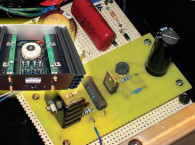With little time to present a project for the annual Burning Amp Festival (BAF) in San Francisco, CA, Michael Rothacher decided to do a preamplifier project using static induction transistors (SITs). He also wanted a versatile preamplifier that would work well in a variety of situations, with ample gain, a lot of voltage swing, high input impedance, low output impedance, low distortion and no feedback, and which could fit conveniently in a suitcase.

The annual Burning Amp Festival (BAF) in San Francisco, CA, is the premier event for DIY audio enthusiasts. Each year the BAF provides handcrafted equipment displays, listening rooms, brilliant talks by audio cognoscenti, raffles, giveaways, sausage, and beer. Last summer I resolved to do whatever it took to attend, and since many of my audio friends and heroes would be there, I didn’t want to go without a DIY project to display. So, I had to come up with something small enough to fit in my suitcase and light enough to schlep from my hotel to the festival, which was held at Fort Mason on the bay.
Paradoxically, in audio invention is oftentimes the mother of necessity, so I decided I needed a preamplifier. All I had to do was design and build a BAF-worthy, good-sounding, unusual preamplifier with a spiffy set of performance specifications and have it show-ready in about two months. Nothing inspires me quite like an unreasonable objective and self-imposed pressure. This is the story of that project, which I named the LuminAria, warts and all.
Design Goals
Starting a design project is easy, but finishing one generally requires some specific goals so we’ll begin there. DIY preamplifier projects are a bit scarcer than amplifier projects; perhaps this is because preamplifiers can be a little more difficult to build, demanding more in terms of switches, volume controls, wiring, metalwork, and so forth. So, when I decided to do a preamplifier project, I knew I wanted something simple, not only to satisfy my minimalist taste, but also to ensure that it may actually get built.
I also decided this would be an active preamplifier with voltage gain. Passive and buffered-passive preamplifiers are popular among audiophiles because they handle input switching and volume control without adding much coloration to the music signal. As long as your amplifiers have enough gain and cooperative input circuits, they do a really great job.
However, I like to experiment with simple little one-stage amplifiers that often require some special attention at the input in terms of voltage and source impedance (see my article, “L’Amp: A Simple SIT Amp,” diyAudio, 2011). I wanted a versatile preamplifier that would address these issues and work well in a variety of situations.
To summarize: a simple, unusual preamplifier with ample gain, a lot of voltage swing, high input impedance, low output impedance, low distortion and no feedback, which fits conveniently in a suitcase would be preferable.
Thanks to Nelson Pass, I’m hooked on static induction transistors (SITs). Their characteristics are great for building simple, low-distortion gain blocks with little or no feedback. Having built a number of single-stage power amplifiers with SITs, I wanted to see if these devices could work their magic in a preamplifier.
You can read the full article here.
About the Author
Michael Rothacher is an executive for a US manufacturing firm by day, and a mad scientist by night. His interests include audio circuit experimentation, circuit-bending, computer programming, and writing.
This article was originally published in audioXpress, April 2014





